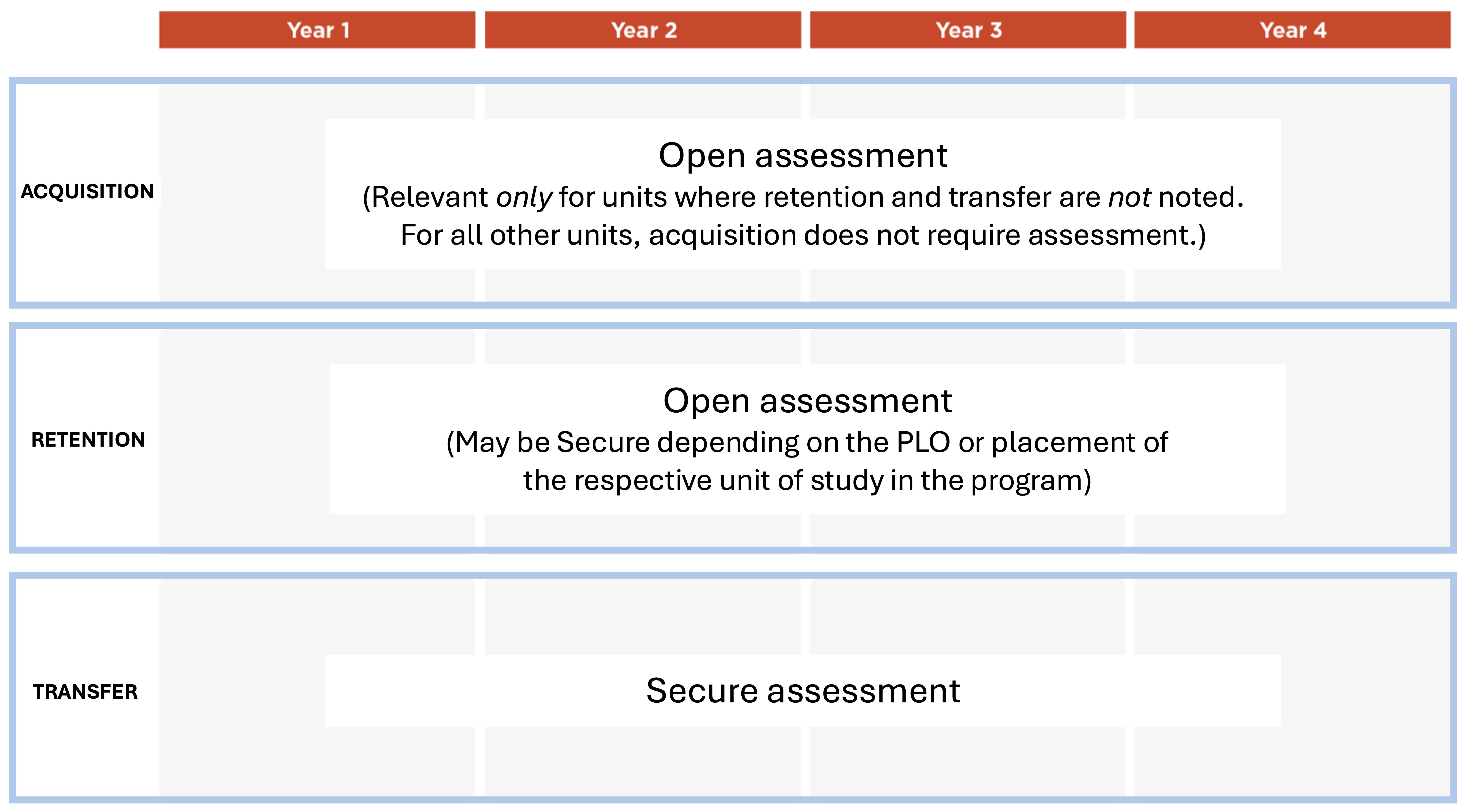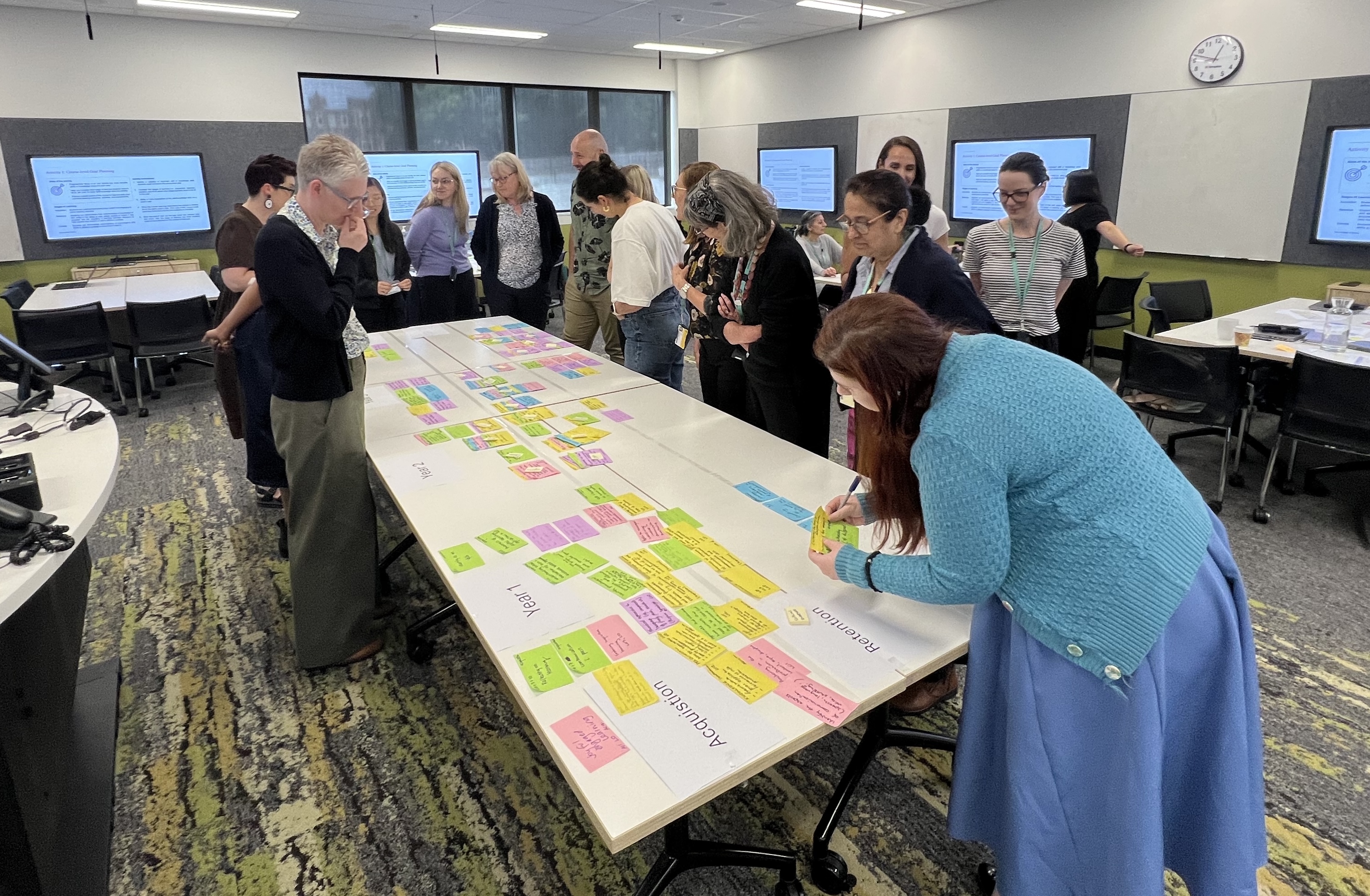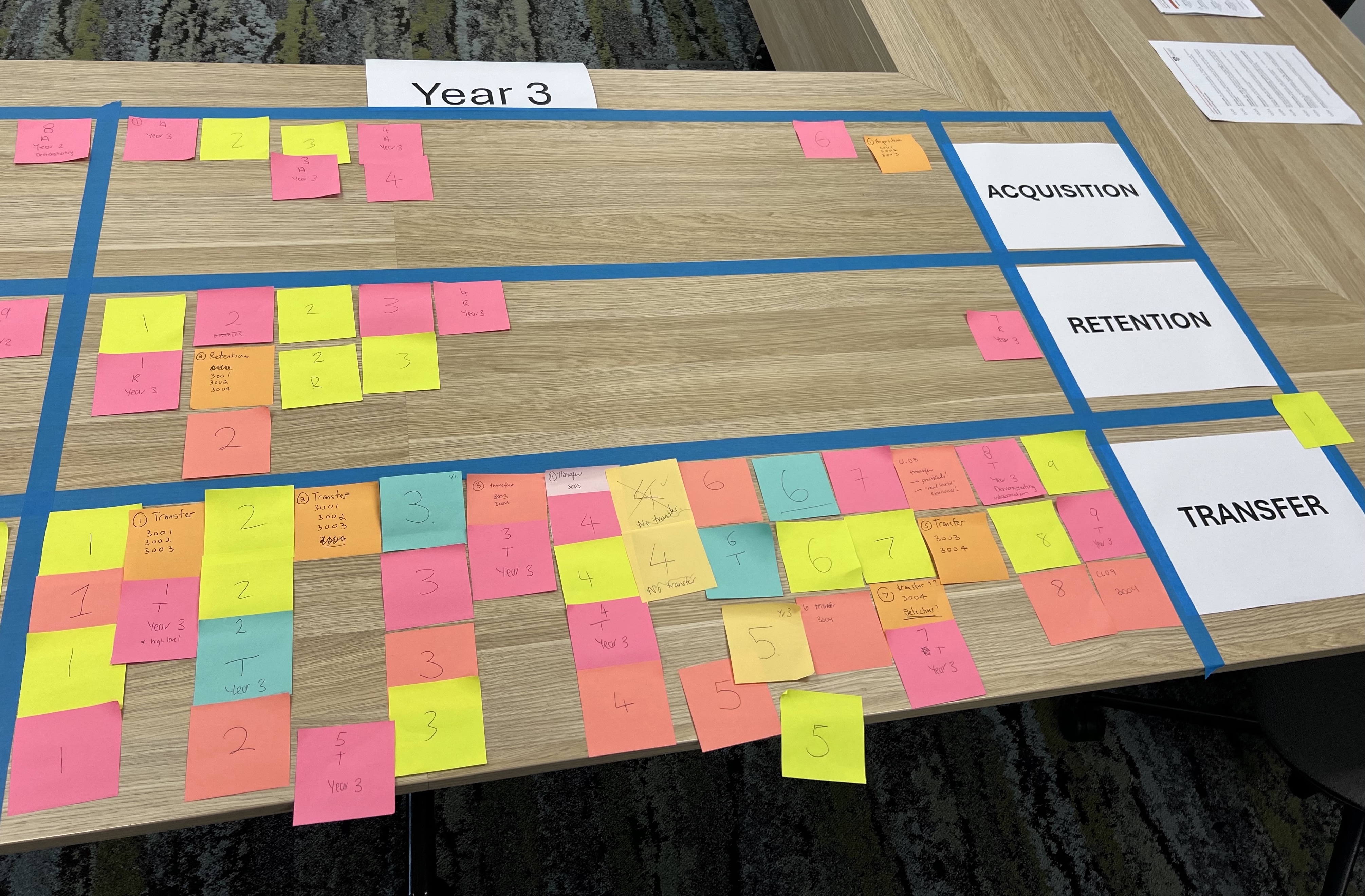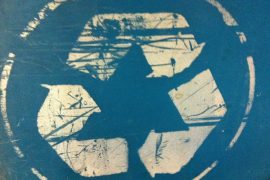The introduction of AI has encouraged us to look at our program designs and ensure that we are thoroughly supporting and assessing learning (Cantú-Ortiz et al., 2020; Dai et al., 2020). With the new assessment policy taking effect at the university in Semester 2 this year, it’s essential that we have a systematic and clear method for determining when assessments should be secure (Lane 1) and when they should be open (Lane 2). Curriculum mapping (also called program mapping or program learning outcome mapping) is a powerful tool for helping us with assessment design. This article outlines a curriculum mapping activity I designed for academics that has successfully been implemented in the Faculty of Medicine and Health to support unit of study design, and particularly determining where secure versus open assessments are optimally placed across a degree to ensure meaningful and effective assessment.
What is curriculum mapping?
Curriculum mapping involves intentionally identifying the learning process for program-level learning outcome (PLO; also known as a Course Learning Outcome) attainment across a degree. The process creates a visual roadmap of the curriculum, informing effective and efficient unit of study design by linking PLOs to unit (1) learning outcomes, (2) content, (3) learning activities (formative), and (4) assessment design (summative; Harden, 2001; Uchiyama & Radin, 2009).
The benefits of good mapping
Intentionally mapping PLOs across a program has shown to positively impact student learning and curriculum quality— when PLOs are not mapped, curricula can lack coherence, leading to a fragmented program with unclear expectations, critical knowledge gaps, unnecessary repetition of content, and poor assessment design (Boud & Falchikov, 2007; Houghton, 2004), therefore reducing student motivation and hindering their performance in the workplace (Boud & Falchikov, 2007; Gibbs & Simpson, 2004; Houghton, 2004).In contrast, when PLOs are mapped, teachers and curriculum developers can ensure that:
- there are no gaps, redundancies, or unnecessary repetition in units and across the program
- the ordering of units is optimal, and
- unit design supports learning required at specific stages of a degree.
For students, mapping sets clear expectations and a coherent learning pathway across the degree that optimally supports their motivation and engagement (Biggs & Tang, 2011; Boud & Molloy, 2012), subsequently enhancing understanding, critical thinking, assessment outcomes, and the integration of knowledge into real-world contexts (Anderson & Krathwohl, 2001; Uchiyama & Radin, 2009).
Program-level assessment design
For assessment specifically, curriculum mapping encompasses a program-level approach to assessment design, ensuring that we are strategically assessing students at key points in their degree, which has shown to reduce the following issues (see Beckwith et al., 2010; Eastberg, 2011; Ndoye & Parker, 2010; Simper et al., 2022):
- assessment burden
- redundant or repetitive assessments,
- misalignment of learning outcomes, and
- over-reliance on traditional assessment types.
Subsequently for teachers, mapping can reduce workload and volume of assessments by streamlining and integrating assessment design, and help us gain a clearer understanding of how our efforts contribute to the program as a whole (Harden, 2001).
Why map our programs now?
While your program and unit(s) of study may have been working very well, the rapid rise of AI is reshaping how students engage in their education or access and process information, and particularly how they demonstrate their learning through assessment (Lodge et al., 2023). This shift is challenging many of the assumptions built into traditional assessment and learning designs in universities, meaning that we need to ensure what we’re doing is optimal for the new climate. Of course, AI is not the first driver of the conversation around assessment. Challenges and limitations of assessments in university education, such as misalignment of learning outcomes with assessment design and over-reliance on traditional assessment types (Hattie, 2009; Shavelson, 2010, 2019), have been widely acknowledged by academics and researchers predating the advent of AI (see ‘assessment culture’ related literature for more information, e.g., Cardoso et al., 2019; Holzweiss et al., 2016; Ylonen et al., 2018). Rather, AI is unveiling new dimensions to existing challenges with assessment and prompting greater urgency in implementing improvements that have long been needed. Engaging in program redesign strategies like the curriculum mapping activity described below will help ensure that, even with a changing educational landscape, our degrees can optimally foster learning and prepare students for the current and emerging workplace.
The curriculum mapping process
Curriculum mapping involves discussing and identifying the learning process for each PLO across the program. By learning process, I mean the point(s) in a program at which students acquire, retain, and transfer each PLO. Acquisition, retention, and transfer of knowledge or skills is a shared, comprehensive, and rigorously understood model for learning across education and learning science related disciplines (Evans et al., 2021; Tierney, 2021). The process of how we learn provides a structure for the activity and systematic breakdown of learning for each PLO across a program (see Table 1). Therefore, the curriculum mapping activity involves academics determining in which year(s) (and semester, if possible) each PLO should be (1) acquired, (2) retained, and (3) transferred. Using post it notes, teachers visually map learning attainment for each PLO across the program (see “Doing the curriculum mapping activity in your program” below for a complete step-by-step guide).
Table 1. The learning process.
| Acquisition: The stage when learners are reading/hearing/watching content and engaging in learning activities (i.e., formative tasks).
Retention: When learners (1) can demonstrate their understanding of knowledge or skills in the same or very similar context to where it was acquired (i.e., assessment) and (2) engage in learning activities designed to help facilitate transfer. Transfer: When learners can ultimately demonstrate their understanding and application of knowledge or skills in different contexts (i.e., assessment). |
| References: e.g., Blume et al., 2010; Cormier & Hagman, 2014; Pellegrino & Hilton, 2012; Schmidt, 1991; Schmidt & Lee, 2005; Sweller, et al., 2011 |
Figure 1. Curriculum mapping activity outcome example.

Applying curriculum mapping results to your unit and assessment design
For unit of study design specifically, activity outcomes clarify how individual units contribute to the overall learning process within a program. This helps educators more systematically:
- Refine unit-level learning outcomes—for example, determining whether students should define concepts or apply knowledge and skills;
- Design teaching strategies, learning activities, and feedback opportunities that support students in achieving the required learning attainment for the unit,
- Ensure assessments are appropriately focused on demonstrating retention and/or transfer of learning, aligned with both the unit learning outcomes and relevant PLOS, and
- Decide whether assessments should be Lane 1 (secure) or Lane 2 (open), depending on whether students need to demonstrate retention and/or transfer of relevant PLOs.
Considering the new Sydney Assessment Framework, let’s look at how you can apply activity outcomes to your assessment design.
Help find gaps or redundancies
Activity outcomes can help us ensure that the content and design of our assessments, whether secure or open, purposefully demonstrates or supports learning. For example, the activity outcomes in Figure 1 show that PLO1 needs to be transferred by Year 2. Let’s say you teach a second-year unit of study that addresses PLO1. Your respective assessment design should therefore aim to demonstrate transfer of learning (e.g., case-based questions are a great way to demonstrate transfer of knowledge to different scenarios in written exams). However, if your assessment design is focused on basic recall of information, the design may require attention. The curriculum map ultimately helps keep the purpose of our assessments clear and aligned with both unit learning outcomes and PLOs.
Help determine secure versus open assessments
Activity outcomes allow for the systematic identification of key points across a degree where students need to demonstrate their learning through assessment (i.e., Lane 1 secure). Figure 2 outlines how the PLO mapping outcomes guide where Lane 1 (secure) and Lane 2 (open) assessments occur across a program. As transfer is an advanced stage of learning (e.g., accreditation bodies often expect that students can demonstrate transfer), this indicates where Lane 1 (secure) assessments should be placed across the degree. While “retention” is well on the road to transfer, the learner is not yet at the stage where they can demonstrate transfer of their knowledge and skills into different contexts and conditions, therefore Lane 2 (open) assessment is appropriate to continue to support the student learning process. Acquisition does not require assessment, unless a unit of study is linked to PLOs that only require acquisition in a respective year, in which case Lane 2 (open) assessment would suffice.
Let’s look at two scenarios from the example activity outcomes in Figure 1 for how to use the map to determine lanes of assessment:
Example 1: Let’s say you teach to PLO1 in your unit, and that your unit is in Year 1. The example curriculum map in Figure 1 shows that PLO1 needs to be acquired and retained in Year 1. Your relevant assessments would therefore be open (Lane 2) to support learning (see Figure 2). It’s ok if the curriculum map indicates that you don’t need any secure assessments in your unit of study. Each PLO must be securely assessed at least once within an entire program.
Example 2: This scenario involves a single PLO that encompasses substantial content and may need to be broken down and assessed at various points across a program. Let’s say you teach a Year 3 unit that addresses part or all of PLO3. The curriculum map in Figure 1 indicates that students need to retain and transfer PLO3 in Year 3, indicating both Lane 2 (open for retention) and Lane 1 (secure for transfer) assessments are required. However, there’s other important information in the map. Results indicate that PLO3 was previously assessed for retention in Year 2 and will be assessed again for transfer in Year 4. To avoid unnecessary repetition (i.e., over assessment), it’s important to assess only the specific aspect(s) of the PLO that your unit covers. To further reduce redundancy and workload, and promote integration of learning across units, this scenario may lend itself to a combined or integrated assessment with other relevant units (for guidance, see the Program level assessment design Teaching@Sydney article).
Figure 2. How activity outcomes may assist in determining whether your assessments should be open or secure.

Doing the curriculum mapping activity in your program
Before commencing the activity:
- I recommend the activity be done in-person and on paper, with no devices used (unless otherwise required for accessibility purposes) to encourage engagement.
- Include Unit Coordinators and academic staff who teach into the degree program, representing as many units from your program as possible.
- There is no need to provide detailed unit content or current assessment information. Keeping information high-level will more optimally attain academic perspectives on the overall picture of learning across the degree (Whitfield & Hartley, 2019).
➕ Materials
- Printed key program information for each academic (provide accessible digital documents for those requiring a device):
- Program Learning Outcomes (PLOs).
- Unit layout across the program.
- Unit information, including: code, name, a brief 1–3 sentence (maximum!) descriptor.
- Unit articulation if available.
- Learning process descriptors (i.e., acquisition, retention, and transfer) provided above presented on a PowerPoint slide for the whole room to see.
- Post-it notes and pens
- A long table (or series of tables pushed together)
- Painter’s tape to mark out a table layout (see Figure 1/photos). Do this on the long table.
- Printed signs for column and row headings on the table (one per year and level of attainment)
➕ Step-by-step activity guide
- Pair up academics: Pair academics with someone from a different unit to encourage varied perspectives on student learning of the PLOs across the program.
- Provide key program information: Provide each academic with the key program information noted in the materials list. Academics can refer to these as needed when mapping.
- Start mapping: Start by mapping the least dense PLO, if possible, to ease into the activity.
- Discuss the learning processes: Have pairs read the PLO and discuss it in relation to the levels of attainment. Meaning, discuss in which year(s) the PLO should be acquired, followed by what year(s) students should retain the PLO, and last when students should demonstrate transfer of the PLO.
- Write outcome on post-it notes: Write the PLO number on post-it notes—one for each level of attainment. There should be a minimum of 3 post-it notes. However, academics may choose to go deeper and split areas of a single PLO, for example, if “demonstrate” and “evaluate” are noted in a single PLO, teachers may wish to split them and state how the “demonstrate” element of the PLO should be attained, and how the “evaluate” element should be attained.
- Map the post-it notes: Stick each one on the table under the appropriate year and in-line with the relevant attainment level.
- Group discussion: Before moving on to the next PLO, discuss the mapping outcomes with the whole group (e.g., thoughts, observations, agreements, disagreements, etc.).
- Repeat: Move onto the next PLO.
- Final review: Look at the completed curriculum map as a group and see if there are any points of discussion.Try to reach agreement for any PLOs where there’s division on how learning should occur. Amend as needed.
➕ How to organise your results
Tally the number of post it notes per PLO, for each level of attainment, and highlight instances where there was high agreement (e.g., over 80%) to generate a heatmap of outcomes. Summarise your results in a clear table (example template below) so that it’s easy for teachers to read and refer to when designing their units of study.
Table 1. What year Program Learning Outcomes are attained across the program
| Level of attainment | |||
| Acquisition | Retention | Transfer | |
| Program Learning Outcome | Year(s) | Year(s) | Year(s) |
| PLO 1: Insert descriptor. | 1 [example] | 2 & 3 [example] | 3 [example] |
| PLO 2: Insert descriptor. | # | # | # |
| PLO 3: Insert descriptor. | # | # | # |
| PLO 4: Insert descriptor. | # | # | # |
| PLO 5: Insert descriptor. | # | # | # |
| PLO 6: Insert descriptor. | # | # | # |
| PLO 7: Insert descriptor. | # | # | # |
| PLO 8: Insert descriptor. | # | # | # |
| PLO 9: Insert descriptor. | # | # | # |
| Note. Where there is equal or high agreement for a level of attainment across multiple years, note all respective years as per the example for PLO1 Retention. | |||
Tell me more!
As our assessment practices evolve, ensuring continued alignment with program learning outcomes becomes critical. This curriculum mapping activity offers a timely and practical tool for guiding program redesign and maintaining that alignment as we move to the new Sydney Assessment Framework. Thank you to the Faculty of Medicine and Health’s Tina Barclay for the opportunity to develop this workshop activity to support curriculum development in the faculty.
If you’re planning a program design or redesign, and you’d like to hear more about this activity or need assistance running it in a workshop with academics, reach out to [email protected]
About me

Introducing myself as this is my first Teaching@Sydney contribution! My PhD and Masters research looked at how learning sciences may improve teacher education and professional development for higher education teachers, particularly teacher use of instruction, demonstration, and feedback for supporting learning and autonomy. While my research started by applying learning sciences to teaching in higher music education, I’ve had the recent privilege of applying the same knowledge to teaching and curriculum developments in the Faculty of Medicine and Health, and now the broader university community.
➕ References
- Anderson, L. W., & Krathwohl, D. R. (Eds.). (2001). A taxonomy for learning, teaching, and assessing: A revision of Bloom’s taxonomy of educational objectives. Longman.
- Beckwith, E. G., Silverstone, S., & Bean, D. (2010). Creating A Culture Of Academic Assessment And Excellence Via Shared Governance. Contemporary Issues in Education Research (Littleton, Colo.), 3(2), 35–48. https://doi.org/10.19030/cier.v3i2.175
- Biggs, J., & Tang, C. (2011). Teaching for quality learning at university: What the student does (4th ed.). Open University Press.
- Blume, B. D., Ford, J. K., Baldwin, T. T., & Huang, J. L. (2010). Transfer of training: A meta-analytic review. Journal of Management, 36(4), 1065–1105. https://doi.org/10.1177/0149206309352880
- Boud, D., & Falchikov, N. (Eds.). (2007). Rethinking assessment in higher education: Learning for the longer term. Routledge.
- Cantú-Ortiz, F. J., Galeano S´ anchez, N., Garrido, L., Terashima-Marin, H., & Brena, R. F. (2020). An artificial intelligence educational strategy for the digital transformation. International Journal on Interactive Design and Manufacturing, 14, 1195–1209. https:// doi.org/10.1007/s12008-020-00702-8
- Cardoso, S., Rosa, M. J., Videira, P., & Amaral, A. (2019). Internal quality assurance: A new culture or added bureaucracy? Assessment and Evaluation in Higher Education, 44(2), 249–262. https://doi.org/10.1080/02602938.2018.1494818
- Cormier, S. M., & Hagman, J. D. (Eds.). (2014). Transfer of learning: Contemporary research and applications. Academic Press.
- Dai, Y., Chai, C. S., Lin, P. Y., Jong, M. S. Y., Guo, Y., & Qin, J. (2020). Promoting students’ well-being by developing their readiness for the artificial intelligence age. Sustainability, 12(16), 6597. https://doi.org/10.3390/su12166597
- Eastberg, J. R. B. (2011). Valuing in Decision-Making Ability: Teaching, Learning, and Assessment Across the Curriculum and Campus Culture at Alverno College. Journal of College and Character, 12(3). https://doi.org/10.2202/1940-1639.1819
- Evans, C., Kandiko Howson, C., Forsythe, A., & Edwards, C. (2021). What constitutes high quality higher education pedagogical research? Assessment and Evaluation in Higher Education, 46(4), 525–546. https://doi.org/10.1080/02602938.2020.1790500
- Gibbs, G., & Simpson, C. (2004). Conditions under which assessment supports students’ learning. Learning and Teaching in Higher Education, (1), 3–31.
- Harden R. M. (2001). AMEE Guide No. 21: Curriculum mapping: a tool for transparent and authentic teaching and learning. Medical teacher, 23(2), 123–137. https://doi.org/10.1080/01421590120036547
- Hattie, J. (2009). Visible learning: A synthesis of over 800 meta-analyses relating to achievement (1st ed.). Routledge. https://doi.org/10.4324/978020388733
- Holzweiss, P. C., Bustamante, R., & Fuller, M. B. (2016). Institutional Cultures of Assessment: A Qualitative Study of Administrator Perspectives. Journal of Assessment and Institutional Effectiveness, 6(1), 1–27. https://doi.org/10.5325/jasseinsteffe.6.1.0001
- Houghton, W. (2004). Engineering subject centre guide: Learning and teaching theory for engineering academics. LTSN Centre for Engineering Education.
Retrieved from https://www.advance-he.ac.uk/knowledge-hub/learning-and-teaching-theory-engineering-academics - Lodge, J. M., Howard, S. K., Bearman, M., Dawson, P., & Associates. (2023). Assessment reform for the age of artificial intelligence. Tertiary Education Quality and Standards Agency. https://www.teqsa.gov.au/sites/default/files/2023-09/assessment-reform-age-artificial-intelligence-discussion-paper.pdf
- Ndoye, A., & Parker, M. A. (2010). Creating and Sustaining a Culture of Assessment. Planning for Higher Education, 38(2), 28–35
- Pellegrino, J. W., & Hilton, M. L. (2012). Education for Life and Work: Developing Transferable Knowledge and Skills in the 21st Century. Washington, DC: National Academies Press.
- Schmidt, R. A., & Lee, T. D. (2005). Motor control and learning: A behavioral emphasis (4th ed.). Human Kinetics.
- Shavelson, R. J. (2010). Measuring college learning responsibly: Accountability in a new era. Stanford, CA: Stanford University Press.
- Shavelson, R. J., Zlatkin-Troitschanskaia, O., Beck, K., Schmidt, S., & Marino, J. P. (2019). Assessment of University Students’ Critical Thinking: Next Generation Performance Assessment. International Journal of Testing, 19(4), 337–362. https://doi.org/10.1080/15305058.2018.1543309
- Simper, N., Mårtensson, K., Berry, A., & Maynard, N. (2022). Assessment cultures in higher education: reducing barriers and enabling change. Assessment and Evaluation in Higher Education, 47 (7), 1016–1029. https://doi.org/10.1080/02602938.2021.1983770
- Sweller, J., Ayres, P., & Kalyuga, S. (2011). Cognitive load theory. Springer. https://doi.org/10.1007/978-1-4419-8126-4
- Tierney, A. 2020. “The Scholarship of Teaching and Learning and Pedagogic Research within the Disciplines: Should It Be Included in the Research Excellence Framework?.” Studies in Higher Education 45 (1): 176–186. doi:10.1080/03075079.2019.1574732.
- Uchiyama, K. P., & Radin, J. L. (2009). Curriculum mapping in higher education: A vehicle for collaboration. Innovative Higher Education, 33(4), 271–280. https://doi.org/10.1007/s10755-008-9078-8
- Whitfield, R, and P. Hartley. 2019. Assessment strategy: enhancement of student learning through a Programme Focus(employability via Higher education: sustainability as scholarship). 237–253. doi:10.1007/978-3-030-26342-3_16.
- Ylonen, A., Gillespie, H., & Green, A. (2018). Disciplinary differences and other variations in assessment cultures in higher education: Exploring variability and inconsistencies in one university in England. Assessment and Evaluation in Higher Education, 43(6), 1009–1017. https://doi.org/10.1080/02602938.2018.1425369







